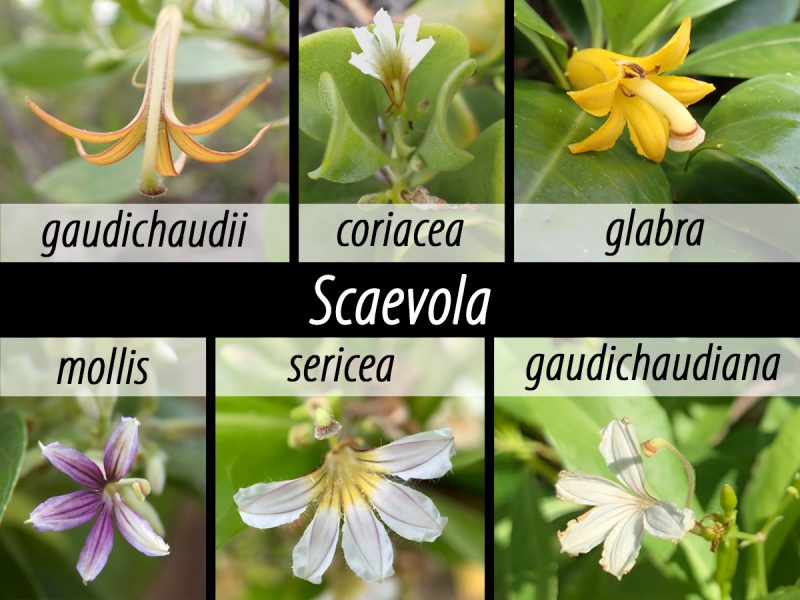Ulu Kanu: Scaevola

Ulu Kanu means “Garden Patch”. It is the new name for the Flora of Hawai‘i section. The hope of these features is three-fold: that we hear more about the plants we see along the trails, learn a little bit about Hawaiian history, and, where possible, are inspired to plant natives in our own gardens.
Why Naupaka?
February is the time for one of those holidays people love or love to hate- Valentine’s Day. And though there is no shortage of romantic stories, one of the tales most commonly told in Hawai‘i is that of the mountain-dwelling Princess Naupaka and her shoreline sweetheart, Kau‘i. In one version, it is said that because their love was forbidden, the two would meet in secret under the moonlight. One night, when they were discovered and Naupaka was separated from her love’s embrace, her tears rained down upon a flower by the sea. The flower, that once grew whole, was turned into half a flower. Though quite well-known, this anecdote and its variations are of recent origin and are not traditional mo‘olelo. So while they are nice yarns to spin, they are not based on an “ancient Hawaiian legend”. Indeed, rather than seeing these blossoms as being incomplete or representing an “other half”, they should be seen as beautiful – and whole – just as they are.
More about Naupaka
Naupaka is part of the Goodenia family, which is made up of perennial herbs, shrubs, or small trees. Key features are the strongly irregular flowers and the presence of a pollen-collecting cup subtending the stigmas. It is represented in Hawai‘i by nine species in a single genus. All but one are endemic, and all are the result of at least three independent colonizations: one being sericea, the other glabra, and then the remaining species. The name scaevola is from the Greek scaevous, meaning left-handed or awkward, probably referring to the shape of the flower.
Pictured at the top of this post are six of the naupaka native to Hawai‘i. Below are their Hawaiian names, what type of native plant they are, and the areas in which they can be found. They are in order from left to right (top row, then bottom row).
Naupaka Kuahiwi – Endemic – Dry ridges and flats in open shrubland and forest
Naupaka Papa – Endemic, Endangered – Coastal sites (primarily sand dunes)
‘Ohe Naupaka – Endemic – Very wet forest
Naupaka Kuahiwi – Endemic – Wet forest on ridges, in valleys, and in boggy areas
Naupaka Kahakai– Indigenous – Sites throughout the Pacific and Indian Ocean coasts
Naupaka Kuahiwi – Endemic – Wet forest and open areas
This might be a good time for a reminder about the terms “indigenous” and “endemic”. First of all, any plant that reached the islands on its own via one of the three dispersal methods is native. The methods are: makani (wind), moana (water), and manu (wing). If a native plant grows naturally elsewhere in the world, it is indigenous. If a native plant only grows naturally in a particular place and nowhere else in the world, it is endemic.
How To Grow It
Sericea is probably the easiest variety to grow.
Seed– Ripen the fruit in a plastic bag and then remove the pulp. You can use some kind of mesh or screen to separate the pulp from the seeds. The seeds can be washed and then dried on a paper towel for storage. When ready to plant, soak the seeds in cool water for 24 hours and plant them about 1/2 in deep in a well-drained potting mix. Germination can take up to three months.
Cutting– After cutting, remove all of the lower leaves and cut the upper leaves in half to minimize water loss. Plant the cuttings in a light, well-drained potting mix or sandy soil. Keep the medium moist by watering once a day.
Once you’ve got your plants prepared and planted, you can count on them for a great hedge that will thrive in full sun and will need very little water or protection from pests.
Sources
CTAHR. “Scaevola sericea.” Hawaiian Native Plant Propagation Database, 2001, http://www2.hawaii.edu/~eherring/hawnprop/sca-seri.htm.
Gustafson, Robert J., et al. Hawaiian Plant Life: Vegetation and Flora. University of Hawai’i Press, 2014.
Handy, E. S. Craighill, et al. Native Planters in Old Hawaii: Their Life, Lore, and Environment. Bishop Museum Press, 1972.
Ka Wai Ola – Office of Hawaiian Affairs, Volume 5, Number 3, 1 March 1988
Neal, Marie C. In Gardens of Hawaii. Bishop Museum Press, 1948.
Wagner, Warren L., Herbst, Derral R. and Sohmer, S.H.. Manual of the Flowering Plants of Hawai’i, University of Hawaii Press, 1990.
